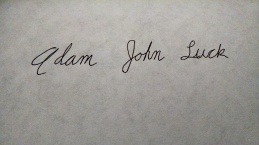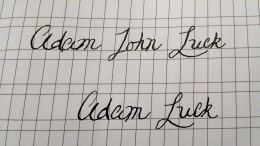To start, I have to comment on how much more difficult writing calligraphy is than I initially thought it was going to be. I expected that once I picked up my pen that I would write these marvelous swooping letters. Now that I’ve been working on this for a few weeks, I realize how ignorant of an idea that was. Calligraphy truly is an art form, and I’ve never considered myself an artist. However, if you notice the before and after photos, you can tell the difference between my normal writing and my calligraphy writing. I’m not pressing so hard on the paper which allows for a nice even flow, letters are spaced better, and there aren’t apparent abrupt stops. It still takes me a long time to write, about 40 seconds to write my name that is only 12 letters long.

Original Handwriting

Practiced Writing
What is nice about calligraphy is that there isn’t any one set type of letter to write. Since it is an art form, it feels as though whatever letter style you want to write is acceptable. Once I practiced writing the alphabet in a new style, which just entailed writing a letter over and over until I found a style I liked, it was just a matter of memorizing that letter. Now, even though it still takes me a long time to write a word, I do not have to constantly look back at my reference page of how I want to write a particular letter. One of the issues I keep running into is since I have practiced a new way of creating letters, they do not always want to flow into one another when connecting them in a word. How I’ve figured to get around that is to break the letters up into several strokes. By breaking the letters up, I am able to prepare how I want to end a particular letter so that it flows nicely into the next one. Notice that I am doing just that in the video. I don’t make the letters “m” or “n” in a continuous humping motion, I pick up the stylus and adjust how I want to continue. Connecting letters still needs work, but I have my style alphabet down.
Another thing I have noticed about my writing is that I usually write very tense and hunched over. I find that if I write like that while doing calligraphy, my forms go back to my original style of chunky and sloppy. I find that calligraphy is rather relaxing, I just have to remember to practice what I’ve been learning online. Holding the stylus a certain way is tantamount for success. The pen needs to be angled a certain direction, not too much pressure can be used, pressure on down strokes needs to be more than on upstrokes, don’t hold the pen too high or too low, sit up straight, don’t move from the wrist, and oddly enough breath. I still have to be mindful of what some sources call these the basics, but if I am, I do notice a significant difference in my writing.
To find all my favorite resources I’ve been using the browser extension StumbleUpon. What it does is add a button to your browser and will bring you to websites that fall under the categories of the interests you have set up for your profile.
When beginning I really appreciated these three sites because it gave a basic primer on how to start:
http://www.discoverahobby.com/learn/Calligraphy
http://www.oheverythinghandmade.com/calligraphy-for-beginners/
https://www.youtube.com/watch?v=KJKMceXl1pk
I also gained a better appreciation for how calligraphy is an art form and that I shouldn’t be so worried about replicating someone else’s perfect letters but to experiment and create my own.
When I was practicing my alphabet I found Carter Sams YouTube videos very helpful in how she explains the creation of your own letter types:
https://www.youtube.com/watch?v=18EZ9Dq1HII
https://www.youtube.com/watch?v=C6CycgclkxI
What I need to continue to practice is varying my pressure in my letters. I’ve noticed that the more professional calligraphers are really able to exaggerate the difference between down and up strokes. My letters tend to only feature a slight difference between the two strokes because of the natural tendency to apply more pressure on a down stroke than on an up. I think this feature, more than any of the others, is what separates good calligraphy from basic and calligraphy in general from handwriting. If I can apply this feature to my regularly writing, I hope it will improve.
Stay tuned for future updates!

I had a former CEP 810 students that took up calligraphy and had a similar experience to yours. It was difficult at first given how much more flowing it is and the practice required. I think it’s interesting the way you tackled this, but practicing a letter repeatedly, rather than tackling entire words to get the flow down. I would have thought trying to get the connections and fluidity in place first would be paramount, but that just shows my own ignorance with this art form.
I was fascinated by the way you noticed your posture and poise while writing; it was enough to actually make me think about how I hold my shoulders while typing on a computer, and noticed something similar. I would be curious to see if continued work on calligraphy produced other hidden revelations about the way you write, and possibly change old habits that helped improve your handwriting overall.
I love the way that you’ve set yourself up for success, not just by outlining what you need to continue to work on, but using StumbleUpon to quickly make note of resources to come back to.
LikeLike